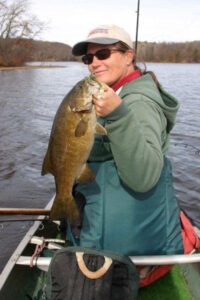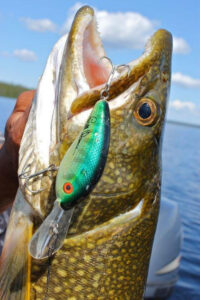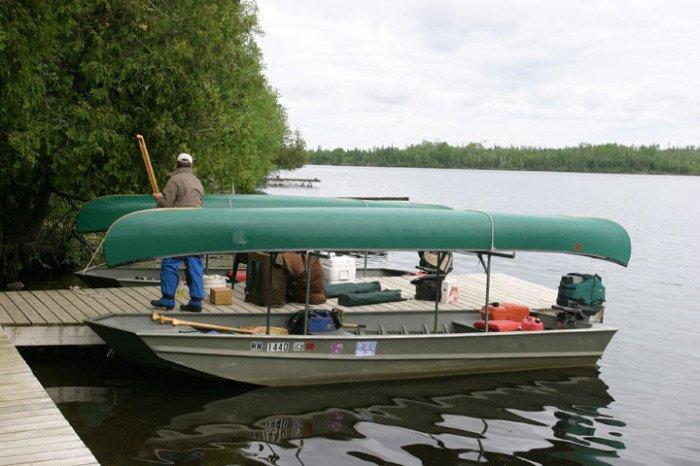Article and Photos By Nathan Shore
Question: I’m going on a Boundary Waters fishing trip. Which lures should I pack?
Answer: Because you need to limit weight, you should pay special attention to lure selection. Below is everything you need to know about packing for a BWCAW trip.
The northeastern corner of Minnesota is the home of the Boundary Waters Canoe Area Wilderness (BWCAW), stretching 120 miles west from the shores of Lake Superior along the Canadian border and the equally impressive Quetico Wilderness Area. It’s an area where families and friends can enjoy nature like it used to be, and the fishing for smallmouth, walleyes, muskies and other gamefish is virtually untapped.
If you’re looking for adventure, join the nearly 200,000 people annually who strike out into the wilds of the BWCAW. Fishing is obviously one of the main draws, but the area also attracts hunters, hikers, bird watchers and other nature lovers. Permits are required (see the end of this article for information) because the BWCAW is all about getting back in touch with our rustic beginnings. Some areas are open to motorboats, but most are restricted to canoes, kayaks and foot travel, and anything motorized (including a power auger) is illegal. The rules guarantee a quiet sojourn for those seeking a true wilderness experience, and with 70 entry points and 1200 miles of canoe-only trails crossing hundreds of lakes, ponds and streams, the BWCAW offers endless possibilities for serene angling in a truly wild setting.
Preparing for Wilderness Fishing
First-time explorers should do some research. Many BWCAW outfitters are on the Internet, and they have gear packing down to a science. Observing what and how they pack for shelter, food preparation, first aid, and other essentials is a college-level class in itself. Several sites (like CanoeCountry.com) offer detailed packing instructions for all times of year.
Few sites, however, explain in detail how to pack for BWCAW fishing. BWCAW fishing can be exceptional and a constant source of food. May and June tend to be the best fishing months, but late summer and fall can be awesome, too. After selecting an entry point and a route, study all information on the lakes or lake you will visit and pack tackle accordingly. The primary species are walleyes, northern pike, smallmouth bass, brook trout, lake trout, bluegills, crappies, perch and whitefish. With the limited space you have to work with, packing for all of those species is tricky. Packing the “must haves” first, then tackle with universal appeal, is key to a successful trip.
Good net is a must
The first “must have” is a net that breaks down for efficient storage, like the Beckman Pen Net. For pike, select the 30-inch hoop. For everything else, the 22-inch hoop is perfect. The Pen Net has a “floor” that keeps fish from flopping out. The sides stay away while unhooking fish—a procedure seldom easy from a canoe. The Pen Net easily holds fish in the water for unhooking for quick release on hot days.
Wrangling fish from a canoe is a different rodeo altogether. Getting a good grip on big predators not only prevents injury for you, but for the fish as well. “Must have” No. 2 is a Lindy Fish Handling Glove. It takes up almost no space yet provides a massive service. In the wilderness, small wounds can become big problems in a hurry (always include a well-stocked first-aid kit, too). The third “must” is something too many first-time visitors forget — a stringer. There are no livewells on those canoes, folks. The light, plastic Lindy Ever-Last Stringer is a perfect choice for keeping fish fresh until dinner.

You might catch walleye, smallmouth, pike, trout and more all on the same pack of lures
Lure variety
Nobody knows what will bite next, so lures that catch a variety of species are important. All of these species respond to a properly presented jig. Bring 1/32- to 3/8-ounce jigs, but focus on the 1/16- to ¼- versions. The two most-universal fish attractants in the world are marabou and soft plastic, so a selection of Lindy Jigs becomes the most versatile way to pack light but effectively. A selection of Lindy Fuzz-E-Grub and Lindy Watsit jig bodies make for compact storage and last through many strikes each.
Making this selection ultra-versatile is the Lindy Jig Spinner. Clip on this safety-pin style Jig Spinner and turn any jig into a spinnerbait for smallmouths and pike, or a more efficient lure for walleyes in wood cover (fallen trees and logs are common in the BWACW). Ten or more jigs of each size, 50 or more plastic bodies and a few Jig Spinners fit in a compact utility box, and will certainly last the week.
Make room in the jig box for a few lighter versions for panfish and brook trout. A Lindy Bug, Toad, or small jig tipped with a piece of crawler under a slip float can be deadly for brookies, crappies and bluegills. Include a few small jig spoons like the Lindy Frostee because crappies and perch in the Boundary Waters are strict minnow eaters. The flash of a Frostee tipped with a piece of leech or crawler creates a compelling minnow imitator.
Like with the jig, hard-baits that catch a variety of species are best. Include floating minnowbaits, suspending minnowbaits, shad-shaped crankbaits, bass-style crankbaits and lipless crankbaits. Devote one utility box to hard baits. Floating minnows like the Bomber Long A can be trolled shallow for pike, walleyes and smallmouths, or trolled deep behind a heavy in-line Lindy Cent’r Slip No-Snagg Sinker weight for lake trout. Suspending minnows like the Smithwick Rattlin’ Rogue attract every species with a twitch-pause-pull retrieve. Shad-shaped cranks like the Lindy Shadling mimic the body shape of ciscoes, a main forage for many BWCAW gamefish, so make sure some of your cranks feature blue backs. Crankbaits like the Bomber Fat Free Shad can take walleyes, smallmouths, pike and lake trout when pitched or trolled between spots.
Live bait anyone?
Carrying minnows is unrealistic, but leeches and night crawlers are “wilderness friendly” and great for tipping jigs for all species, which brings up another universal fish catcher: The infallible crawler harness or basic spinner rig. Some anglers bring components to match blade sizes and colors to conditions (blades, clevises, and swivels), but who wants to spend precious minutes on a wilderness trip tying spinner rigs? More than 100 pre-tied rigs can be packed in a quart or gallon-sized storage bag, taking up very little space.
Terminal tackle for land and sea
Because you must travel light, use snag-free sinker designs like the No-Snagg Sinker so you can cut back on the number you have on hand. A half-dozen each of the Cent’R Slider, No-Snagg and Rattlin’ No-Snagg in sizes from ¼- to ¾-ounce will suffice.
Consider that not all fishing will be from the canoe. You’ll want to fish from camp, too, so pack three or four Thill Pro Series Slip Floats and a half-dozen lighted floats for night fishing, along with a selection of plain bait hooks and a small container of soft shot.
Loud colors work
Because you’ll be waging a war of attrition throughout the trip, weight your color patterns heavily toward chartreuse, brown/orange, blue and natural perch patterns. Chartreuse shows up best in stained waters, but many waters are clear, making a case for translucent plastics and natural minnow patterns. Crayfish are prolific in all Boundary Waters lakes, making craw-pattern cranks and jigs key items. Another dominant source of protein is the cisco or lake herring, which reflects a lot of blue. Blue jigs and lures with blue backs get crushed.
This is no “peanut wrangle.” The Boundary Waters have produced Minnesota state records for walleye, brook trout, pike, and lake trout. Make like a Boy Scout and be prepared. Take equipment and lures designed to handle behemoths and bring home no regrets from the wilderness canoe trip of a lifetime.
Getting Permits
Groups staying overnight need quota permits and may only enter the BWCAW on the entry date, and must enter through the entry point specified. To apply, contact:
BWCAW Reservation Center
P.O. Box 462
Ballston Spa, NY 12020
Phone: 877/550-6777













